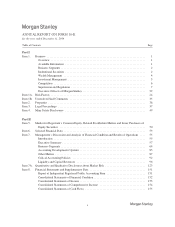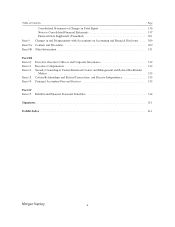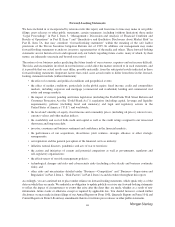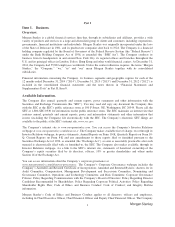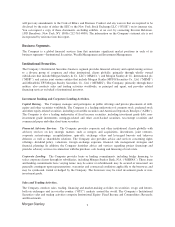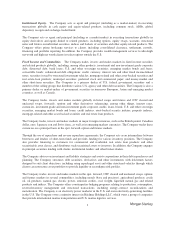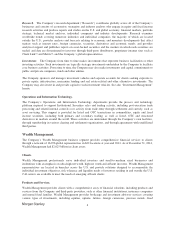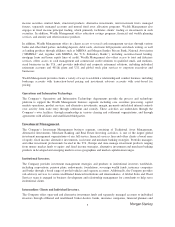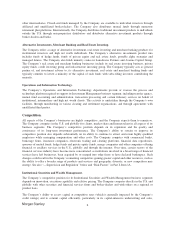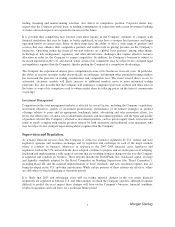Morgan Stanley 2014 Annual Report Download - page 12
Download and view the complete annual report
Please find page 12 of the 2014 Morgan Stanley annual report below. You can navigate through the pages in the report by either clicking on the pages listed below, or by using the keyword search tool below to find specific information within the annual report.
Financial Holding Company.
Consolidated Supervision.
The Company has operated as a bank holding company and financial holding company under the BHC Act since
September 2008. As a bank holding company, the Company is subject to comprehensive consolidated
supervision, regulation and examination by the Federal Reserve. As a result of the Dodd-Frank Act, the Federal
Reserve also gained heightened authority to examine, prescribe regulations and take action with respect to all of
the Company’s subsidiaries. In particular, as a result of the Dodd-Frank Act, the Company is, or will become,
subject to (among other things) significantly revised and expanded regulation and supervision, to more intensive
scrutiny of its businesses and plans for expansion of those businesses, to new activities limitations, to a systemic
risk regime that imposes heightened capital and liquidity requirements, to new restrictions on activities and
investments imposed by a section of the BHC Act added by the Dodd-Frank Act referred to as the “Volcker
Rule” and to comprehensive new derivatives regulation. In addition, the Consumer Financial Protection Bureau
has primary rulemaking, enforcement and examination authority over the Company and its subsidiaries with
respect to federal consumer protection laws, to the extent applicable.
Scope of Permitted Activities. The BHC Act places limits on the activities of bank holding companies and
financial holding companies, and grants the Federal Reserve authority to limit the Company’s ability to conduct
activities. The Company must obtain Federal Reserve Board (“FRB”) approval before engaging in certain
banking and other financial activities both in the U.S. and internationally. Since becoming a bank holding
company, the Company has disposed of certain nonconforming assets and conformed certain activities to the
requirements of the BHC Act.
In addition, the Company continues to engage in discussions with the Federal Reserve regarding its commodities
activities, as the BHC Act also grandfathers “activities related to the trading, sale or investment in commodities
and underlying physical properties,” provided that the Company was engaged in “any of such activities as of
September 30, 1997 in the United States” and provided that certain other conditions that are within the
Company’s reasonable control are satisfied. If the Federal Reserve were to determine that any of the Company’s
commodities activities did not qualify for the BHC Act grandfather exemption, then the Company would likely
be required to divest any such activities that did not otherwise conform to the BHC Act. At this time, the
Company believes, based on its interpretation of applicable law, that (i) such commodities activities qualify for
the BHC Act grandfather exemption or otherwise conform to the BHC Act and (ii) if the Federal Reserve were to
determine otherwise, any required divestment would not have a material adverse impact on its financial
condition. After issuing an advance notice of proposed rulemaking in January 2014 on certain aspects of financial
holding companies’ physical commodities activities and merchant banking investments in nonfinancial
companies, the Federal Reserve stated that it is considering a range of possible actions to address the risks
associated with these activities and investments, including additional capital, risk management and reporting
requirements, and indicated that it will issue a formal notice of rulemaking regarding such matters in 2015.
Activities Restrictions under the Volcker Rule. In December 2013, U.S. regulators issued final regulations to
implement the Volcker Rule. The Volcker Rule will, over time, prohibit “banking entities,” including the
Company and its affiliates, from engaging in certain prohibited “proprietary trading” activities, as defined in the
Volcker Rule, subject to exemptions for underwriting, market making-related activities, risk-mitigating hedging
and certain other activities. The Volcker Rule will also require banking entities to either restructure or unwind
certain investments and relationships with “covered funds,” as defined in the Volcker Rule, subject to certain
exemptions and exclusions. Banking entities have until July 21, 2015 to bring all of their activities and
investments into conformance with the Volcker Rule, subject to certain extensions. In addition, the Volcker Rule
requires banking entities to establish comprehensive compliance programs designed to help ensure and monitor
compliance with restrictions under the Volcker Rule.
The Volcker Rule also requires that certain deductions be made from a bank holding company’s Tier 1 capital for
certain investments in covered funds. These deductions do not yet apply and in any event must be reconciled by
the applicable regulators with the U.S. Basel III capital requirements discussed below.
8


